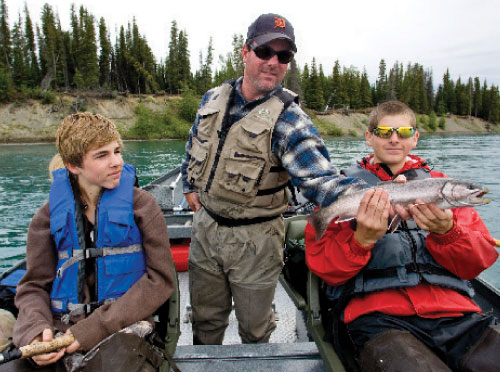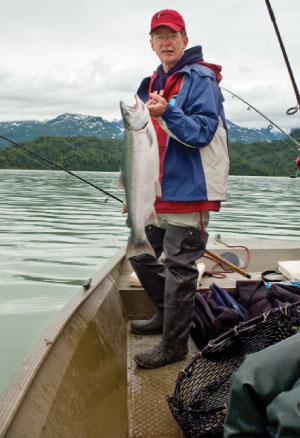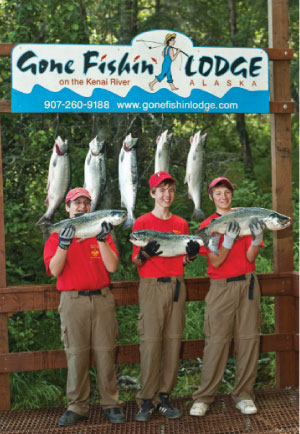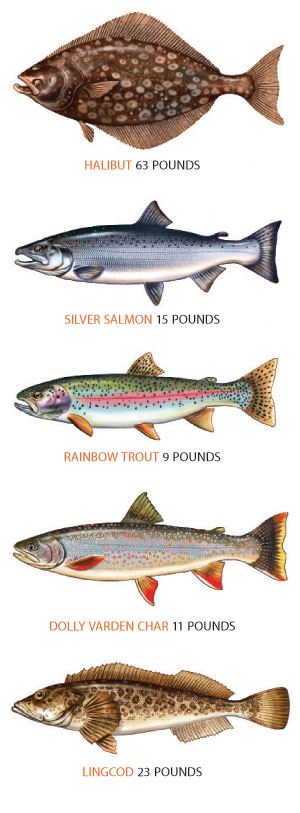Just for the Halibut?
Hardly? Ohio Troop 520 also traveled 3,100 miles to fish Alaska's Kenai River for salmon, trout, and Northern pike, reeling in some lessons about hard work along the way.
Story and photographs by Dan Morrison
 One that didn't get away: Andrejs Mantenieks (left) and fishing guide Ryan Shay (center) admire Frank Zona's catch. |
It’s no secret: Teenage boys like video games and big-screen TVs. When given the chance, they stay up late and sleep in as long as you let them. If asked, they might even tell you they don’t like to crawl out of a cozy bed before dawn, don layers of cold-weather gear, and head out into the icy drizzle of a frosty winter morning. Unless you give them a good reason.
Assistant Scoutmaster Ray Dancik of Troop 520 in Hinckley, Ohio, came up with one—a fishing trip 3,100 miles from home.
After meeting representatives from an Alaska fishing lodge at a sportsmen’s show a few years ago, Dancik and his two Scout sons, Nick and Chris, were hooked. “What immediately attracted me to the lodge was the large fish you could catch there,” Dancik said. “Like halibut. The prices seemed reasonable, and my son Christopher told me, ‘Dad, I’d really like to do this.’”
Dancik floated the idea at the troop’s annual program-planning conference and launched an exciting troop trip. All that stood in the way was money. The boys needed $2,000 apiece. So the enterprising Scouts started selling first-aid kits and fire extinguishers by going door-to-door and visiting local businesses. Two years later, Troop 520 hung out the “Gone Fishin’” sign.
“I don’t like to think that Scouting is just work,” explained assistant Scoutmaster Wayne Kosman. “They need to have fun sometimes.”
 Scoutmaster Chuck Newhauser hauls in his catch of the day, a large silver salmon. |
Joey Langan agrees. The 14-year-old took part in money-earning efforts that led to 11 Boy Scouts and 12 adults from Troop 520 making the trip. The boys even paid for their parents to go. Which explains, in part, why when Joey stood on Alaska’s Kenai River, reeling in a 13-pound, 11-ounce silver salmon his first day casting, the experience meant more to him than just bragging rights. That fish represented something of his past, present, and future.
As an already accomplished writer, Joey wants to become a novelist someday. He viewed the fishing trip as a chance to learn about working hard to achieve a goal and researching a future literary effort. “I’ve heard how the mountains can inspire landscape-driven books,” he said. “I wanted to see the terrain.”
Joey’s salmon didn’t wind up as the biggest catch that week, and his experience might not spawn another The Old Man and the Sea. Never mind. As any high school English teacher can tell you, the fish wasn’t really the point of Hemingway’s story.
Just like when the ear-to-ear grins, the bragging about who caught the most or the biggest fish, and the observations that “This is so much better than I thought it would be!” began to replace the boys’ 4 a.m. grumbling, the Scout leaders knew the time, the temperature, and the lure of electronic pastimes weren’t the point, either.
Once you leave Alaska’s cities—and there aren’t that many cities—you’re surrounded by some of the most breathtaking scenery the world has to offer. Stunning, snowcapped mountains dominate the landscape. Tall waterfalls cascade from steep cliffs and feed meandering rivers. Bald eagles perch arrogantly on limbs of tall, evergreen trees. Gangly moose, all thick torsos atop spindly legs, casually stride along the roadways.
Although Alaska has been part of the United States for more than 50 years, the state still seems like a different country to most first-time visitors—especially those from Ohio.
Alaska has gained deserved fame for its record-setting catches. Anglers have snagged a 97-pound, 4-ounce king salmon, a 459-pound halibut, and a 42-pound, 3-ounce rainbow trout in the state. OK, so maybe those giants weren’t caught at the Gone Fishin’ Lodge in Soldotna, where the Scouts and Scouters headed after loading up five rented minivans in Anchorage and heading 150 miles south. So what? The framed photographs on the walls at the lodge suggest visitors have done all right, landing a 285-pound halibut and a king salmon that weighed more than 60 pounds.
 Proud Scouts Tommy Shimandle, Andrejs Mantenieks, and Cory Kosman had plenty to show for their day on the river, having caught a mess of salmon. |
“What makes this place special,” lodge co-owner Ralph Crystal explained, “is that there’s so much diversity in what you can fish for here.” Indeed, the Kenai Peninsula is home to many species of salmon, as well as halibut, rockfish, and steelhead trout. Freshwater fish include Northern pike, Rainbow trout, and Arctic char. Over the next seven days, each of Troop 520’s kids and adults took part in at least four fishing expeditions that netted 1,284 pounds of fish fillets to take home to Hinckley.
After picking up the basics of fly-fishing on the Kenai River, reeling in king and silver salmon, Justin Yonkers hauled in a 72-pound halibut at Cook Inlet that was nearly as long as he is tall. For most of the group, though, just catching any species or size of fish was exciting.
“It was my first time where I actually had to fight the fish,” Andrejs Mantenieks said. “I’ve never seen fish that big. Not on the end of my pole anyway.”
Cory Kosman agreed. “Catching salmon is fun but a little tough,” he said. “They put up a pretty good fight.”
The boys also worked on requirements for their Fishing merit badge. Jacob Berg earned his by catching, cleaning, filleting, and cooking fish under the watchful eye of his father, assistant Scoutmaster Jim Berg. Jacob then served his culinary handiwork to the group for dinner.
Some of the Scouts, though, saw the Alaska trip as more about sharing time with their buddies. “I’m not a big fishing guy,” said Tommy Shimandle. “I like to hang out with my friends. And I’m getting to do a lot of that.”
Why shouldn’t they enjoy their time together? The boys had worked hard for it. Beginning in 2005, Dancik explained, the Scouts’ short-term goal was “to earn $250 per quarter. The mid-term goal was that at the end of the first year they were to have $1,000 in their Scout account. And the long-term goal was that they would eventually earn the full $2,000 and get to go to Alaska.
“We started with a couple of hundred dollars we had earned parking cars for a rodeo. That was our seed money. From that, $200 had to go for summer camp. That was required. They had to go to summer camp because we didn’t want to take Scouts on this trip who had never been away from home.”
 End of the Line: Here are some of Troop 520's big catches during their trip to Alaska's Kenai River. Illustration by Steve Sanford |
“It taught the boys money management,” added Pete Langan. “They stood in front of banks selling popcorn, giving people change. They had the cash box, and if they came up short … Well, they came up short on their own.”
The Scouts learned other important lessons, too—like Be Prepared. “They learned that when you make a goal, make it attainable,” Dancik said. “If you set it too high, you’ll fail, and you’ll be less likely to want to go forward. So we set reasonable goals, short-term goals, and gave them support.”
As the week in Alaska wound down, Troop 520’s volunteer leaders extended even more support to some members of the troop.
One morning, instead of rousing the boys before dawn, several adults decided to book a fly-out—a fishing trip to an area so remote that they could get there only by floatplane. They consulted Dick Bowen, co-owner of the Gone Fishin’ Lodge, who engaged a nine-passenger de Havilland DHC 3-Otter and agreed to serve as their guide.
The group took a 45-minute flight to Big River Lake, where they transferred to a flat-bottom, outboard motor boat. Bowen, who has spent 15 years guiding visitors around that part of Alaska, steered the craft to a patch of weeds protruding from the lake, baited everyone’s hooks with silver salmon eggs, and instructed them to toss the bait near the plants.
“You watch,” he told the group, “the women will be the first to catch something.”
Sure enough, within minutes committee members Pat Newhauser and Cindy Dancik had hauled in good-size salmon. And soon, everyone had bagged their two-fish limit, including Scoutmaster Chuck Newhauser and assistant Scoutmaster Peter Phillips.
Still, everyone wanted to see bigger game: a bear. “I think I can find you a bear,” Bowen said. All he asked was “How close do you want to get?”
Revving up the outboard again, he took the group to a body of water that flows down into Big River Lake from a hillside. Called Wolverine Creek, it’s where visitors can see a mass of sparkling fins in the shallows and then watch the salmon fall into line, wiggling and jumping their way upstream to spawn and die in their predictable natural ritual. Just as predictably, the local bear population turns up every afternoon in hopes of a meal.
Predictable or not, the Scouters were awestruck riding in a boat just a dozen feet from a mother grizzly and her two cubs, while three adolescent bears warily waited their turn at the fish buffet.
By the end of the week, Troop 520’s Scouts and Scouters had accumulated enough fishing tales to last a lifetime. “We all caught fish,” said assistant Scoutmaster Scott Shimandle, “and it was positive all the way around. Life is an adventure.” The sort of real-life adventure not found in a video game or on a big-screen TV.
Long hours of money earning, planning, and travel time had paid off. On the last day, Scouts and Scouters loaded their gear and boxes of frozen fish into the vans to head back to Anchorage and then home, “It’s the type of thing that starts out as a dream, an idea,” Newhauser said, “and you take it one step at a time. There’s a process involved. It’s really the process of success. That’s one of the things we’re working to do. Teach the boys how to be successful.”
Papa Hemingway would have approved.
Adventure-travel writer Dan Morrison has contributed to Outside and Backpacker magazines. He teaches photojournalism at the University of Oregon in Eugene.